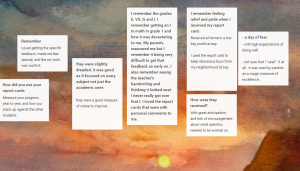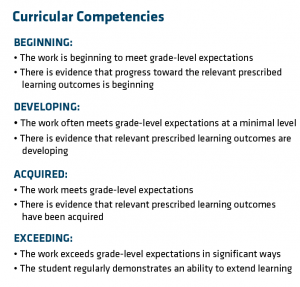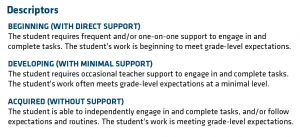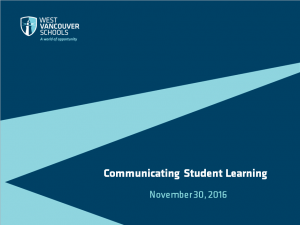Different, or Just New? Communicating Learning K-7
December 4, 2016 - 7 minutes readRecently, BICS Vice-Principal Laura Magrath and I hosted a Communicating Student Learning Information Evening. In response to major changes to BC’s curriculum, the way teachers communicate student learning has also been changing over the last two years.
We started the information session by soliciting parent’s recollections of their own report cards. These recollections ranged from dread to excitement and they highlighted a number of things we should avoid (letters  or numbers that make people feel labelled) and what we should strive for (“specific feedback, made me feel special”; “they were a good measure of where to improve”) in our newest iterations of written reports.
or numbers that make people feel labelled) and what we should strive for (“specific feedback, made me feel special”; “they were a good measure of where to improve”) in our newest iterations of written reports.
In my mind the new Communicating Student Learning written reports which will be sent home with students on December 16 are a vast improvement over our previous report cards. When reading and using the report card, I hope families notice a nd find useful these five elements of the CSL documents.
nd find useful these five elements of the CSL documents.
First, the reports are very clear on the foundational skills. For primary reports (Kindergarten to Grade 3) and intermediate reports (Grades 4-7), students are given clear descriptors for a student’s abilities to read, write and use numbers to solve problems. In the primary report, the terms beginning, developing and acquired are used as descrip tors referring to varying levels of support required for a student to demonstrate the skill assessed. The descriptors are based on the idea that all students can be successful; it is a matter of how much support they require to be successful with our goal of students becoming independent. At the intermediate level, the terms beginning, developing, acquired and exceeding are used. The terms are designed for parents to know precisely which areas of learning the student needs to focus on in the terms ahead.
tors referring to varying levels of support required for a student to demonstrate the skill assessed. The descriptors are based on the idea that all students can be successful; it is a matter of how much support they require to be successful with our goal of students becoming independent. At the intermediate level, the terms beginning, developing, acquired and exceeding are used. The terms are designed for parents to know precisely which areas of learning the student needs to focus on in the terms ahead.
Second, the reports focus to a greater level on what students can do. Many of the learning objectives identified in the primary report as Concepts and Content and in the intermediate report as Curricular Competencies refer to the skills needed for a specific subject; i.e. what skills does a scientist or a historian need? This focus on what the child can do aligns nicely with our feeder school Rockridge Secondary School which uses a report which places a strong focus on what students can do, with limited focus on what the student knows.
Third, the reports also give a clear picture of the big ideas and concepts students know about and understand. Transformational learning is learning that will affect how a student approaches, processes and understands future experiences. Transformational learning is often perspective shaping. When a student develops a deep understanding of big ideas, which are chosen because they are timeless and transferable, the learning can often be transformational. Therefore, while the most important and longest lasting takeaways from elementary school are skills (personal and social, reading, writing and using numbers to solve problems), understandings are still vitally important and readers of the report will see the topics and content of students’ inquiries clearly stated.
Fourth, the reports continue to include information on a child’s social and emotional development. In the opening comments, in Core Competencies (for intermediate reports), and in other fields, teachers share information on the child’s social and emotional development. Schools share the role with parents of supporting a child’s well-being and development of personal and social skills. In the opening comments, teachers also refer to an aspect of our school goal of students developing their learning character so parents will find comments related to a child’s development of Responsibility, Openness, Ambition and Resilience (ROAR).
Fifth, areas of growth for each student to help foster a child’s independence and confidence are very clearly identified. The Supporting Student Learning (primary) and Ways to Support (intermediate) sections of the report give a concise explanation of learning that the child needs to focus on as well as some strategies for school and home to support these needs.
In addition to the comments from teachers, the reports also include reflections from students. BICS teachers will be refining student reflections throughout the year so as to accurately and authentically capture student voice on the process of learning. Our hope is for students to thoughtfully reflect on the process of their learning: were they committed to the strategies identified to achieve their learning goals? Were they successful not just in achieving their goals but more importantly in having the responsibility and resilience to stick to a plan to achieve them?
Teachers, school administrators and school district staff have worked hard to develop written reports that add to the strategy of communicating student learning. We hope these documents, in addition to parent/teacher conferences, student-led conferences, and ongoing feedback in the form of assignments sent home, phone calls and emails, help families understand the progress of their children. This year, all of our K-7 reports are considered pilots so we will be seeking further feedback throughout the year to ensure we are providing the most useful tools to communicate student learning.
Click below to see the slide deck from Laura Magrath for our presentation to parents on November 30.

Recent Comments